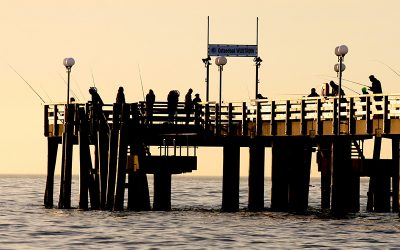by Dr. Julie Ball IGFA Representative,Virginia Beach
As the weather continues to warm, the spring fishing trend will continue to evolve, showing promise for a good saltwater fishing season.
The biggest attraction for anglers during the month of May is always the emerging drum scene. As reports of drum activity filter in, the excitement builds as many folks gather crabs and head for the Eastern Shore shoals in the Chesapeake Bay. Big red drum will provide action among the shoals and sloughs near Smith and Fisherman’s Island. This activity should continue to improve over the next weeks, especially as we approach the next full moon. The best early red drum action is often found among the surf and breakers, where some nice rockfish are also mixed in. These beautiful red fish can weigh in at over 50-pounds, but remember that all reds must be released once pushing over 26-inches. The black drum bite also continues to evolve this month, with most of the early season black drum action occurring along the Eastern Shore seaside inlets, surf, and near buoys 13 and 16 on the Bayside, with the smaller fish arriving first. Clams are the best offerings for black drum, but crabs will also work at times. This trend will also continue to heat up over the next few weeks, and larger fish will become more common.
Some folks will try their luck at striped bass, participating in the bay’s Spring Trophy Striped Bass season this month, but be sure to check these regulations carefully. The first cobia are a possibility towards the end of the month as they swim to their spawning grounds in the rivers of the lower Chesapeake Bay, but familiarize yourself with the new guidelines, which are still restrictive. Cobia season runs from June 1st to September 15th in non-Federal waters within 3-miles of shore. You can keep one fish per day, with a daily boat possession limit at three fish this year. The minimum size limit is 40-inches, with one fish per vessel allowed to be longer than 50-inches, with no gaffing of the cobia allowed. This year, all anglers, captains, and guides must obtain a Recreational Cobia Permit from the Commission and report all harvest and cobia fishing activity.
Pier anglers excel in early Spring as medium-sized croaker and small spot, along with scattered sea mullet kick off the pan-fish season with decent catches happening at most lower bay fishing piers this month. Blood worms are always a good bet for enticing these local favorites.
Good numbers of keeper flounder are common in the Eastern Shore seaside inlets and the back waters of Oyster, while both Lynnhaven and Rudee Inlets can also offer a good introduction to the flatfish trend in May. The lower bay flounder fishery will also pick up once the water temperatures stabilize, usually towards the end of the month. This year you can keep four flounder per person at 17-inches or longer.
Anglers will continue to hook some speckled trout, healthy puppy drum and nice bluefish in Rudee Inlet and along the ocean front this month, where some early season Spanish mackerel are also a possibility.
Tautog are still very active on lower bay and inshore structures, but now these fish are only available for catch and release until September. Big seabass are also available on these same structures, and you can begin keeping them again on the 15th of the month. Each person can keep up to 15 seabass measuring at least 12.5-inches. Look for sheepshead to become active towards the end of the month along the Chesapeake Bay Bridge-Tunnel, and spadefish will also begin to gather at the Chesapeake Light Tower, on inshore shore wrecks, and along the Bay Bridge-Tunnel.
Blueline tilefish ranging up to 16-pounds, wreckfish, and other deep water species are still available in deeper water over 50 fathoms when the weather allows boats to reach them. The upcoming opening of seabass season on May 15th has many anglers excited about making the run.
The offshore fishing scene should heat up off Virginia later this month. The action is already going strong off North Carolina, where the offshore fleet typically targets nice gaffer dolphin and yellowfin tuna this month. Scattered blue marlin will start to make things interesting as they become more common. Hopefully, this trend will continue as it moves northward to Virginia waters.
For more information, go to www.drjball.com
